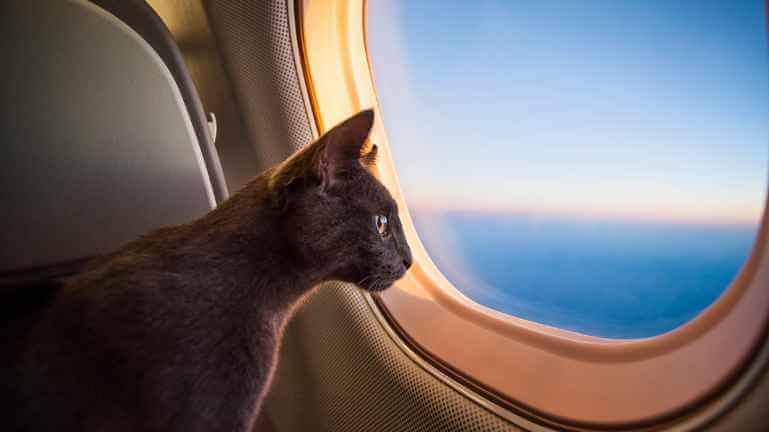Traveling with a cat presents a unique set of challenges and considerations that require careful planning and patience.
Unlike dogs, cats are often more attached to their environment than to their owners, making travel a potentially stressful experience for them. Here is why you should understand your cat’s needs and behavior to ensure a comfortable journey for both you and your feline companion.
This guide aims to provide you with essential tips and strategies to make traveling with your cat a smoother and more enjoyable experience.
Choose the Right Carrier
Select a carrier that is spacious enough for your cat to stand, turn around, and lie down comfortably. Ensure it’s well-ventilated, secure, and escape-proof.
Soft-sided carriers are ideal for car travel, while hard-sided ones are required for air travel. Comfort and safety should be the top priorities.
Familiarizing Your Cat with the Carrier
Introduce the carrier to your cat well before the trip. Leave it open in a familiar area, placing a favorite blanket or toy inside.
Encourage exploration and relaxation in the carrier with treats and positive reinforcement.
This gradual introduction helps the carrier become a safe, comforting space for your cat.
Health Check and Vaccinations
Schedule a visit to the vet for a health checkup and ensure all vaccinations are up to date.
Discuss any travel-related health concerns and get necessary preventive treatments, like flea and tick control. Obtain a health certificate if required, especially for air travel or crossing state lines.
Packing Essentials for Your Cat
Pack your cat’s essentials including their regular food, water, bowls, litter box, litter, scoop, and waste bags. Include familiar items like bedding and toys to provide comfort.
Don’t forget a leash and harness if your cat is trained to use them, and any grooming supplies needed.
Preparing for Emergencies
Carry a copy of your cat’s medical records and ensure they have proper identification, such as a microchip and a collar with ID tags.
Note down the contact details of veterinarians in your destination area. Pack a basic first-aid kit for pets, including any specific medications your cat may need.
Acclimating Your Cat to Travel
Start with short trips to acclimate your cat to travel. Begin by just sitting in the car with your cat in the carrier, then progress to short drives around the neighborhood. Gradually increase the duration of the trips. Ensure each experience is positive to build your cat’s confidence and comfort.
Securing the Carrier in the Vehicle
In the vehicle, secure the carrier with a seatbelt to prevent it from shifting or tipping during the drive. Place it in a spot where your cat can see you but is not exposed to direct sunlight or strong air conditioning. Stability and visibility can help reduce your cat’s stress.
Managing Food and Water
Offer water to your cat regularly, especially on long journeys, to keep them hydrated. Stick to their regular feeding schedule but offer smaller portions to prevent motion sickness.
Avoid feeding right before the journey. Collapsible bowls are convenient for space-saving and easy access during travel.
Handling Rest Stops and Breaks
Plan for regular rest stops on long drives, ideally every 2-3 hours.
Use this time to offer water, a chance to use the litter box, and a break from the confines of the carrier. Ensure the car is secure and escape-proof when opening the carrier.
Dealing with Anxiety and Stress
To manage anxiety and stress, maintain a calm demeanor as cats can sense your emotions. Use pheromone sprays or diffusers in the carrier for a calming effect. Soft, soothing music or silence can also help. Avoid sudden movements or loud noises that could startle your cat.
Maintaining Routine and Comfort

Try to maintain your cat’s routine as much as possible. Familiar objects like blankets or toys in the carrier can provide comfort. If your cat is used to specific playtimes or cuddle sessions, try to incorporate these into your travel schedule to give them a sense of normalcy.
Air Travel with Cats
For air travel, check airline policies in advance as they vary. Choose a flight-friendly carrier and familiarize your cat with it. During the flight, keep the carrier under the seat in front of you. Avoid feeding your cat right before the flight to prevent air sickness.
Creating a Safe Space
Upon arrival, designate a quiet area as your cat’s safe space. Set up their carrier, bed, litter box, food, and water in this area. This familiar setup provides a sense of security amidst the new surroundings. Let your cat explore this space at their own pace to reduce anxiety.
Gradual Introduction to New Surroundings
Introduce your cat to the new environment gradually. Start by allowing them to explore one room at a time. Stay close to provide reassurance. Once they seem comfortable, gradually open up more of the space. This slow approach helps prevent overwhelming your cat and eases their transition.
Monitoring Health and Behavior
Observe your cat closely for any changes in behavior or appetite, which could indicate stress or health issues. Ensure they are eating, drinking, and using the litter box regularly. If you notice any concerning signs, such as lethargy or refusal to eat, consult a veterinarian promptly.
Exploring Safely
If your cat is accustomed to going outdoors, start with short, supervised outings in a secure area. Consider using a harness and leash for control. Always ensure your cat is microchipped and wearing a collar with ID tags in case they wander off or get lost.
Maintaining Familiar Routines
Maintain your cat’s familiar routines as much as possible, including feeding times, play sessions, and cuddling. Consistency in daily activities provides comfort and helps your cat adapt to the new environment. Familiar routines are especially important in the first few days after arrival.
Adjusting to the New Environment
Be patient as your cat adjusts to their new environment. Provide plenty of love and reassurance. Encourage exploration and play to build confidence. Gradually introduce any new routines or changes. With time and patience, most cats will adapt and become comfortable in their new surroundings.
Frequently Asked Questions
How do I prepare my cat for travel?
Gradually acclimate your cat to their carrier and short trips in the car. Ensure they are comfortable with their travel environment and maintain a routine.
Can I give my cat sedatives for travel?
Consult with your veterinarian before administering any sedatives. Some cats may benefit from them, while for others, they may not be suitable.
What should I pack for traveling with my cat?
Pack their carrier, familiar bedding, food, water, litter box, toys, and any necessary medications. Also, bring cleaning supplies for accidents.
Is it safe to travel with my cat in a car?
Yes, if the cat is securely placed in a carrier it is then safely positioned and secured in the vehicle.
How often should I stop when traveling with my cat?
For long car journeys, plan to stop every 2-3 hours to allow your cat to use the litter box and drink water.
Can my cat travel with me on an airplane?
Many airlines allow cats in the cabin. Check with the airline for specific pet policies and prepare an airline-approved carrier.
Conclusion
Traveling with a cat can be a smooth and enjoyable experience with the right preparation and mindset. From choosing the right carrier to maintaining their routine, each step is crucial in ensuring your cat’s comfort and safety. Remember to gradually acclimate your cat to travel, pack all necessary items, and be prepared for emergencies. Consult your vet for health checks and travel advice. With patience and careful planning, you can ensure a stress-free journey for both you and your feline companion, making your travels an enjoyable adventure for all.

